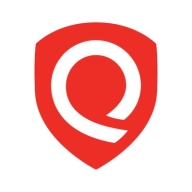


AWS GuardDuty and Qualys TotalCloud compete in the cloud security category. Based on the data, Qualys TotalCloud appears to have the upper hand due to its robust feature set and multi-platform support.
Features: AWS GuardDuty seamlessly integrates with AWS to enhance threat detection capabilities. It benefits from deep integration with native AWS services, which strengthens its platform-specific security posture. Qualys TotalCloud stands out for its multi-cloud support and comprehensive security features, which make it versatile across different environments. It offers robust tools for vulnerability management, configuration assessment, and compliance across varied platforms.
Room for Improvement: AWS GuardDuty could enhance customization options and improve visibility for non-AWS resources. Users would also like to see more flexibility in data visualization. Qualys TotalCloud could improve dashboard functionality and streamline reporting efficiency. Enhancements in user interface design would also benefit cross-platform usability and provide a more intuitive experience.
Ease of Deployment and Customer Service: AWS GuardDuty provides ease of deployment due to its alignment with AWS environments, allowing for quick setup and solid support. Qualys TotalCloud, although requiring a steeper learning curve for non-cloud-specific scenarios, provides extensive support resources that help ensure user satisfaction. AWS GuardDuty is straightforward for AWS deployments, whereas Qualys TotalCloud offers comprehensive support for multi-cloud implementations.
Pricing and ROI: AWS GuardDuty is perceived as cost-effective within AWS environments, offering a good ROI for AWS-based solutions. Qualys TotalCloud, viewed as a premium option, justifies its price with extensive features across multiple environments, reflecting in positive ROI experiences. Decision-making may hinge on budget and scope of coverage, with Qualys TotalCloud catering to those needing broader, versatile solutions.



SentinelOne Singularity Cloud Security protects cloud workloads, offering advanced threat detection and automated response. It integrates seamlessly with cloud environments and secures containerized applications and virtual machines against vulnerabilities.
SentinelOne Singularity Cloud Security is renowned for its efficiency in mitigating threats in real-time. The platform integrates effortlessly with existing cloud environments, ensuring robust cloud security management with minimal manual intervention. Securing containerized applications and virtual machines, it excels in threat intelligence and endpoint protection. However, improvements are needed in performance during high workload periods, and more integrations with third-party tools and better documentation would be beneficial. Users often find the installation process complex, support response times slow, and the dashboard's navigation unintuitive.
What are the key features of SentinelOne Singularity Cloud Security?In specific industries, SentinelOne Singularity Cloud Security is implemented to safeguard critical data and infrastructure. Organizations in finance, healthcare, and technology depend on its real-time threat detection and automated response to protect sensitive information. Its ability to secure containerized applications and virtual machines is particularly valuable in dynamic environments where rapid scaling is necessary.
Amazon Guard Duty is a continuous cloud security monitoring service that consistently monitors and administers several data sources. These include AWS CloudTrail data events for EKS (Elastic Kubernetes Service) audit logs, VPC (Virtual Private Cloud) flow logs, DNS (Domain Name System) logs, S3 (Simple Cloud Storage), and AWS CloudTrail event logs.
Amazon GuardDuty intuitively uses threat intelligence data - such as lists of malicious domains and IP addresses - and ML (machine learning) to quickly discover suspicious and problematic activity in a user's AWS ecosystem. Activities may include concerns such as interactions with malicious IP addresses or domains, exposed credentials usage, or changes and/or escalation of privileges.
GuardDuty is able to easily determine problematic AWS EC2 (Elastic Compute Cloud) instances delivering malware or mining bitcoin. It is also able to trace AWS account access history for evidence of destabilization. such as suspicious API calls resulting in changing password policies to minimize password strength or anomalous infrastructure deployments in new or different never-used regions.
GuardDuty will continually alert users regarding their AWS environment status and will send the security discoveries to the GuardDuty dashboard or Amazon CloudWatch events for users to view.
Users can access GuardDuty via:
Amazon Elastic Kubernetes Service (Amazon EKS)
Kubernetes protection is an optional add-on in Amazon GuardDuty. This tool is able to discover malicious behavior and possible destabilization of an organization's Kubernetes clusters inside of Amazon Elastic Kubernetes Service (Amazon EKS).
When Amazon EKS is activated, GuardDuty will actively use various data sources to discover potential risks against Kubernetes API. When Kubernetes protection is enabled, GuardDuty uses optional data sources to detect threats against Kubernetes API.
Kubernetes audit logs are a Kubernetes feature that captures historical API activity from applications, the control plane, users, and endpoints. GuardDuty collates these logs from Amazon EKS to create Kubernetes discoveries for the organization's Amazon EKS assets; there is no need to store or turn on the logs.
As long as Kubernetes protection remains activated, GuardDuty will continuously dissect Kubernetes data sources from the Amazon EKS clusters to ensure no suspicious or anomalous behavior is taking place.
Amazon Simple Cloud Storage (S3) Protection
Amazon S3 allows Amazon GuardDuty to actively audit object-level API processes to discover possible security threats to data inside an organization's S3 buckets. GuardDuty continually audits risk to the organization’s S3 assets by carefully dissecting AWS CloudTrail management events and AWS CloudTrail S3 data events. These tools are continually auditing various CloudTrail management events for potential suspicious activities that affect S3 buckets, such as PutBucketReplication, DeleteBucket, ListBucket, and data events for S3 object-level API processes, such as PutObject, GetObject, ListObject, and DeleteObject.
Reviews from Real Users
“The most valuable features are the single system for data collection and the alert mechanisms. Prior to using GuardDuty, we had multiple systems to collect data and put it in a centralized location so we could look into it. Now we don't need to do that anymore as GuardDuty does it for us.” - Arunkumar A., Information Security Manager at Tata Consultancy Services
TotalCloud is the Qualys approach to Cloud Native Application Protection Platform (CNAPP) for cloud infrastructure and SaaS environments. With TotalCloud, customers extend TruRisk insights (transparent cyber risk scoring methodology) from the Qualys Enterprise TruRisk Platform to their cloud environments allowing for a seamless unified view of cyber risk across on-prem, hybrid, and multi-cloud environments.
Features and capabilities of Qualys TotalCloud include, but are not limited to:
Discover: Complete visibility and insights into cyber-risk exposure across multi-cloud. Continuously discover and monitor all your workloads across a multi-cloud environment for a 360-degree view of your cloud footprint. Identify known and previously unknown internet-facing assets for 100% visibility and tracking of risks.
Assess: Comprehensive cloud-native assessments with FlexScanTM. Extensive scanning capabilities with Qualys FlexScan, including no-touch, agentless, API- and snapshot-based scanning, along with agent- and network-based scanning for in-depth assessment. Use these multiple scanning methods to scan a workload to get a unified and comprehensive view of vulnerabilities and misconfigurations.
Prioritize: Unified security view to prioritize cloud risk with TruRiskTM. Experience a unified risk-based view of cloud security with insights across workloads, services, and resources. Qualys TruRisk quantifies security risk by workload criticality and vulnerabilities; it correlates with ransomware, malware, and exploitation threat intelligence to prioritize, trace, and reduce risk.
Defend: Real-time protection against evolving and unknown threats with InstaProtectTM. Qualys enables continuous monitoring of all cloud assets to ensure they are protected against threats and attacks at runtime. Qualys keeps your cloud runtime safe by detecting known and unknown threats across the entire kill chain in near real-time across a multi-cloud environment.
Remediate: Fast remediation with QFlow – no code, drag-and-drop workflows. The integration of QFlow technology into Qualys TotalCloud saves security and DevOps teams valuable time and resources. Automation and no-code, drag-and-drop workflows help simplify the time-consuming operational tasks of assessing vulnerabilities on ephemeral cloud assets, alerting on high-priority threats, remediating misconfigurations, and quarantining high-risk assets.
We monitor all Cloud Workload Protection Platforms (CWPP) reviews to prevent fraudulent reviews and keep review quality high. We do not post reviews by company employees or direct competitors. We validate each review for authenticity via cross-reference with LinkedIn, and personal follow-up with the reviewer when necessary.